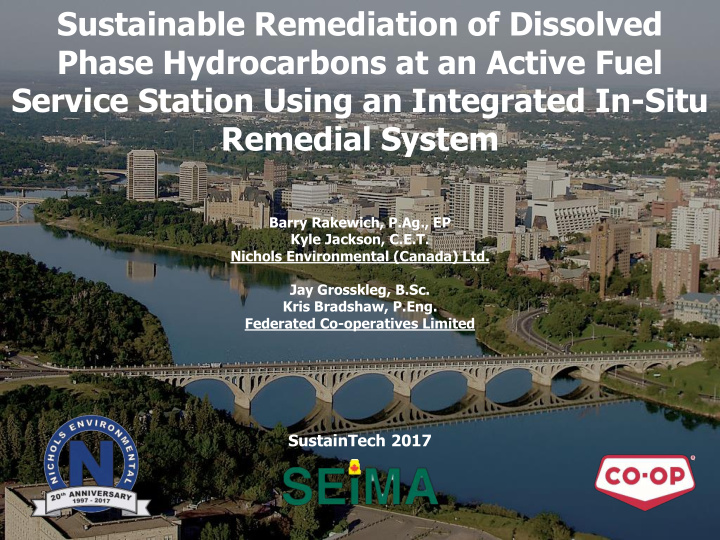



Sustainable Remediation of Dissolved Phase Hydrocarbons at an Active Fuel Service Station Using an Integrated In-Situ Remedial System Barry Rakewich, P.Ag., EP Kyle Jackson, C.E.T. Nichols Environmental (Canada) Ltd. Jay Grosskleg, B.Sc. Kris Bradshaw, P.Eng. Federated Co-operatives Limited SustainTech 2017
Sustainable Remediation of Dissolved Phase Hydrocarbons at an Active Fuel Service Station Using an Integrated In- Situ Remedial System Sustainable – minimize waste disposal Active – operational facility Integrated – multiple remedial options In-Situ – in the place
History May 2012 May 2012 July 2012 October 2012 Benzene Water supply Initial Phase II Leak detection investigation/ testing = failed reported in ESA indoor air sump turbine potable water supply monitoring 10 MWs August 2015 July 2015 May 2014 April/July 2013 Remediation Water Supply Phase II ESA System Repaired Phase II ESA 5 MWs Installation 18 MWs October 2015 OPERATION AND Additional System MAINTENANCE Installation
Site Location
Site Detail - Utilities
Site Detail – Monitoring Wells
PHC & LNAPL Plumes
Approach Integrated/multi-faceted Mechanical extraction of vapours and GW On-site treatment capability Air sparge delivery Nutrient/oxidant amendment delivery Eliminate disposal of impacted media ZERO DOWN TIME
Conceptual Site Model
Remediation Infrastructure
Remediation Infrastructure
Water Line Replacement
Extraction Wells Lines 1 and 2
Extraction Wells Lines 1 and 2
Secured Compound
Monitoring Well Installation
Extraction Wells Lines 3 and 4
Results System operational for ~300 days during 2015 and 2016 On-site recovery and treatment of ~138,000 L impacted groundwater Mechanical removal of ~3,000 KG of PHCs Dissolved phase PHCs concentrations reduced by 84%
Groundwater Contours - Pre Treatment
Groundwater Contours – Post Treatment
HVCs – Pre Treatment
HVCs – Post Treatment
Overall PHC Reduction
Overall PHC Reduction
Overall PHC Reduction
Overall PHC Reduction
Conclusions Mass mechanical removal of fluids/vapour has been achieved Evidence of bio-degradation occurring as indicators of denitrification and anaerobic reduction are evident Reaching the tipping point between effective mechanical removal and transition to bio-degradation
Conclusions Continue fluid/vapour recovery into 2017 Utilize recovered and treated groundwater for amendment preparation Advantage: maintain consistency with native groundwater chemistry and indigenous bacteria Advantage: eliminate discharge requirements System hardware can be utilized for amendment delivery
Recommend
More recommend